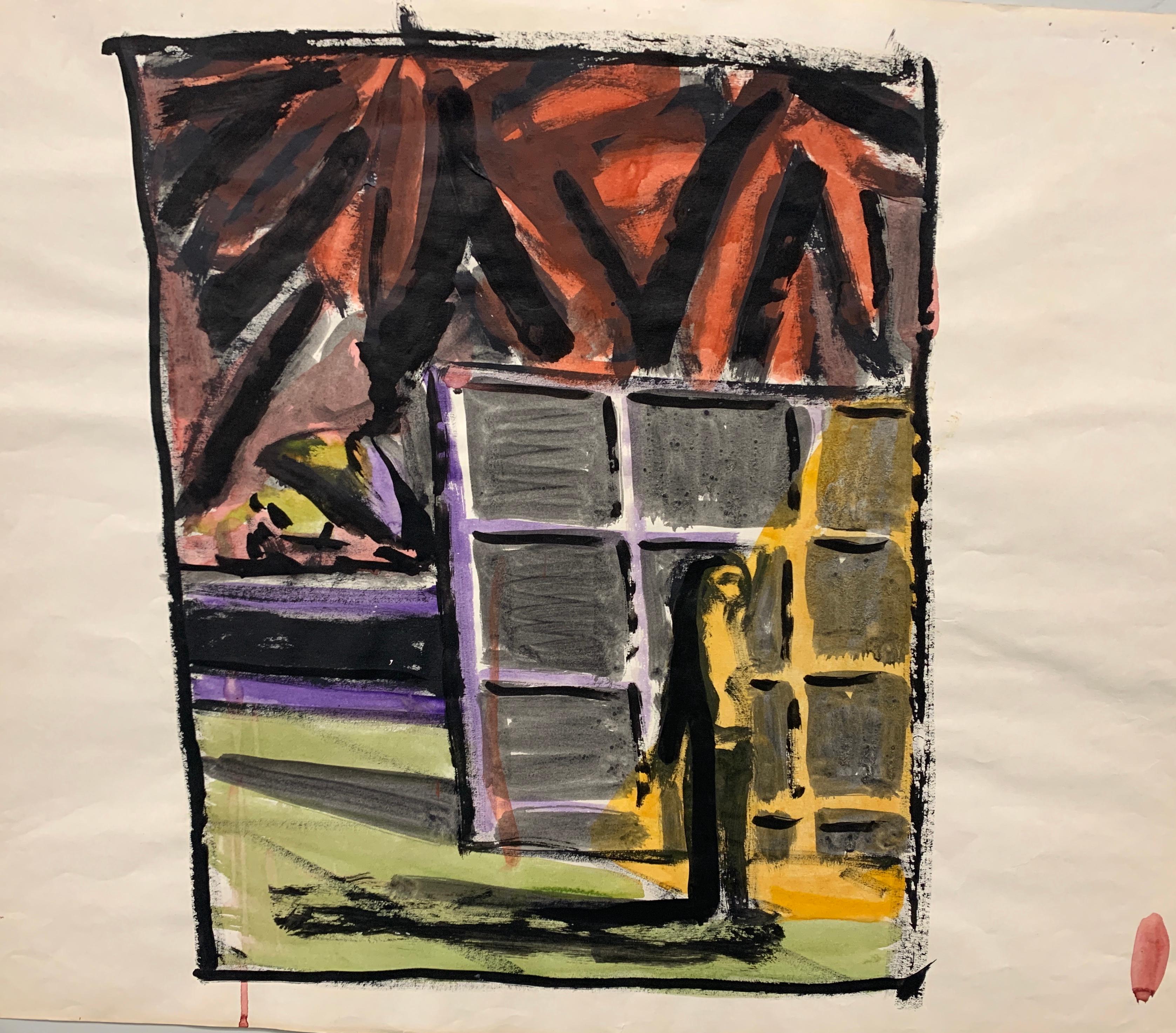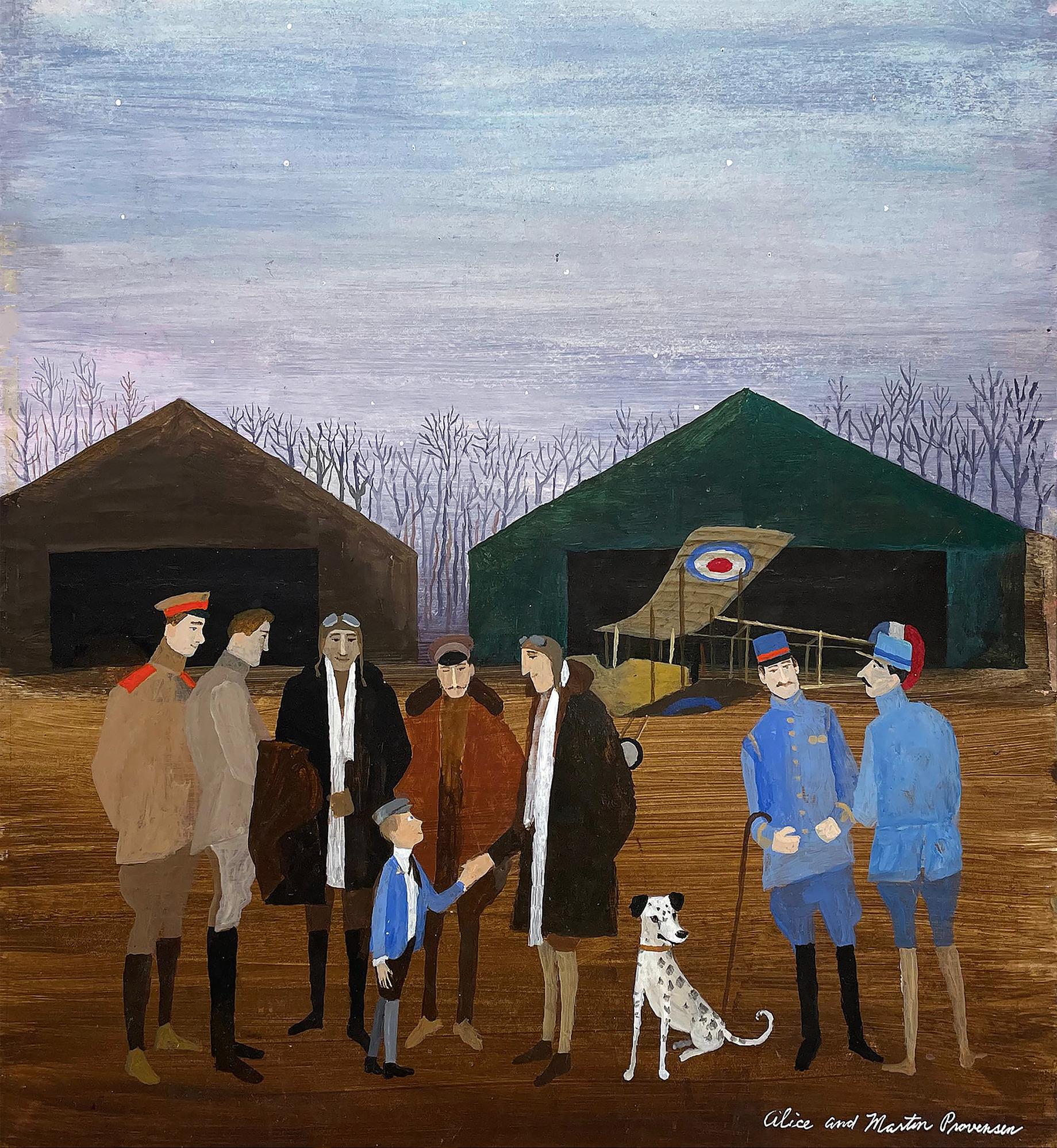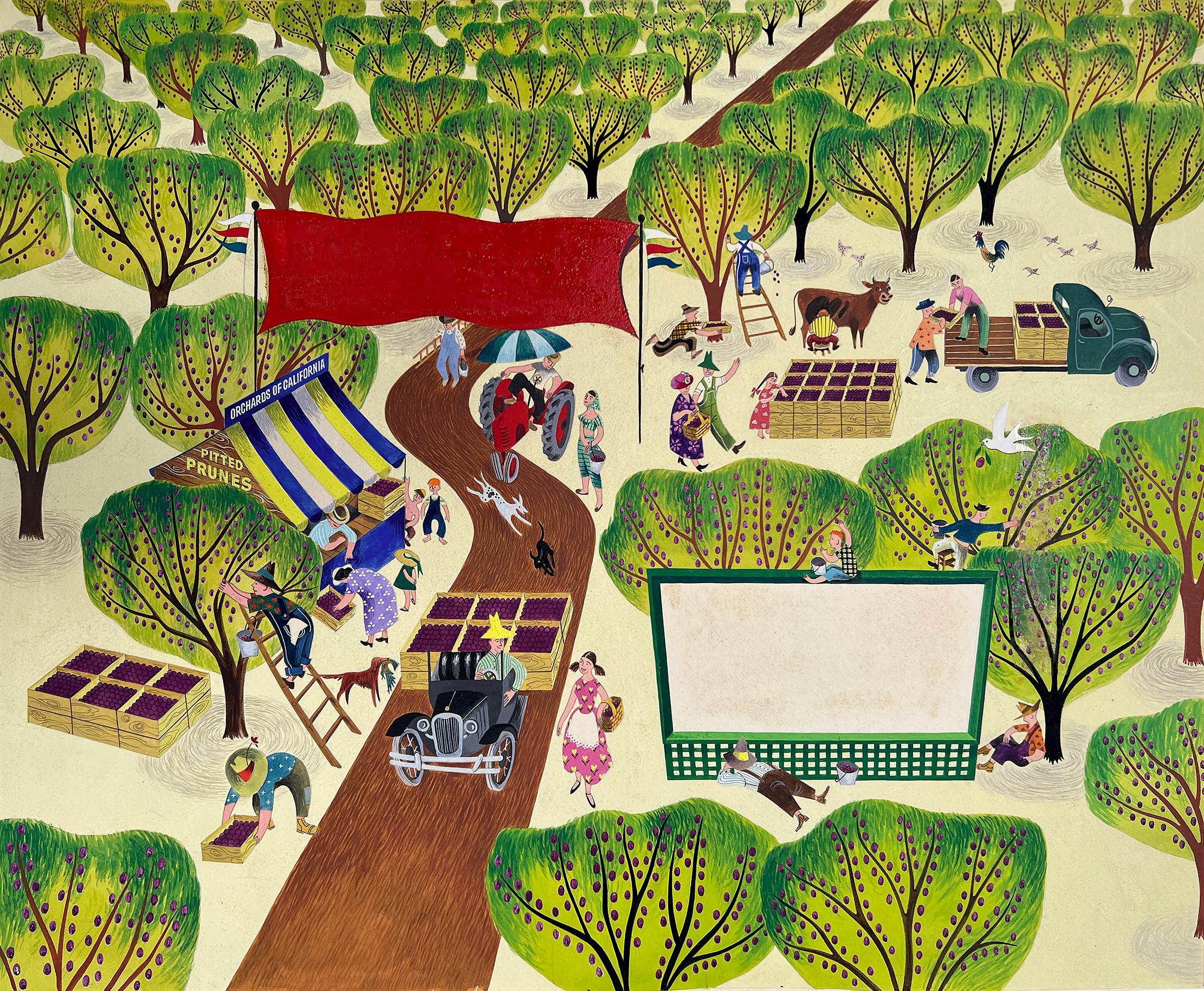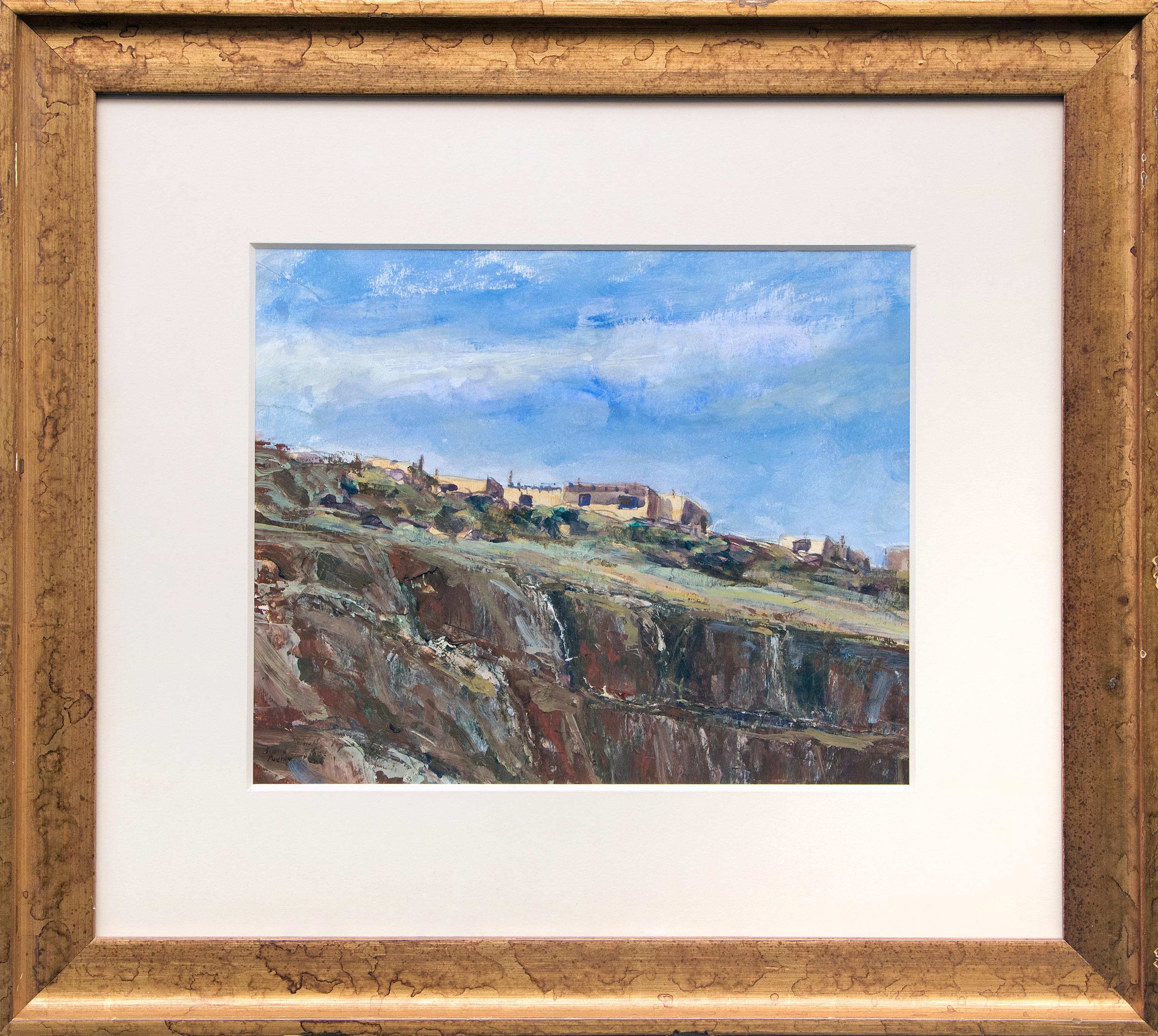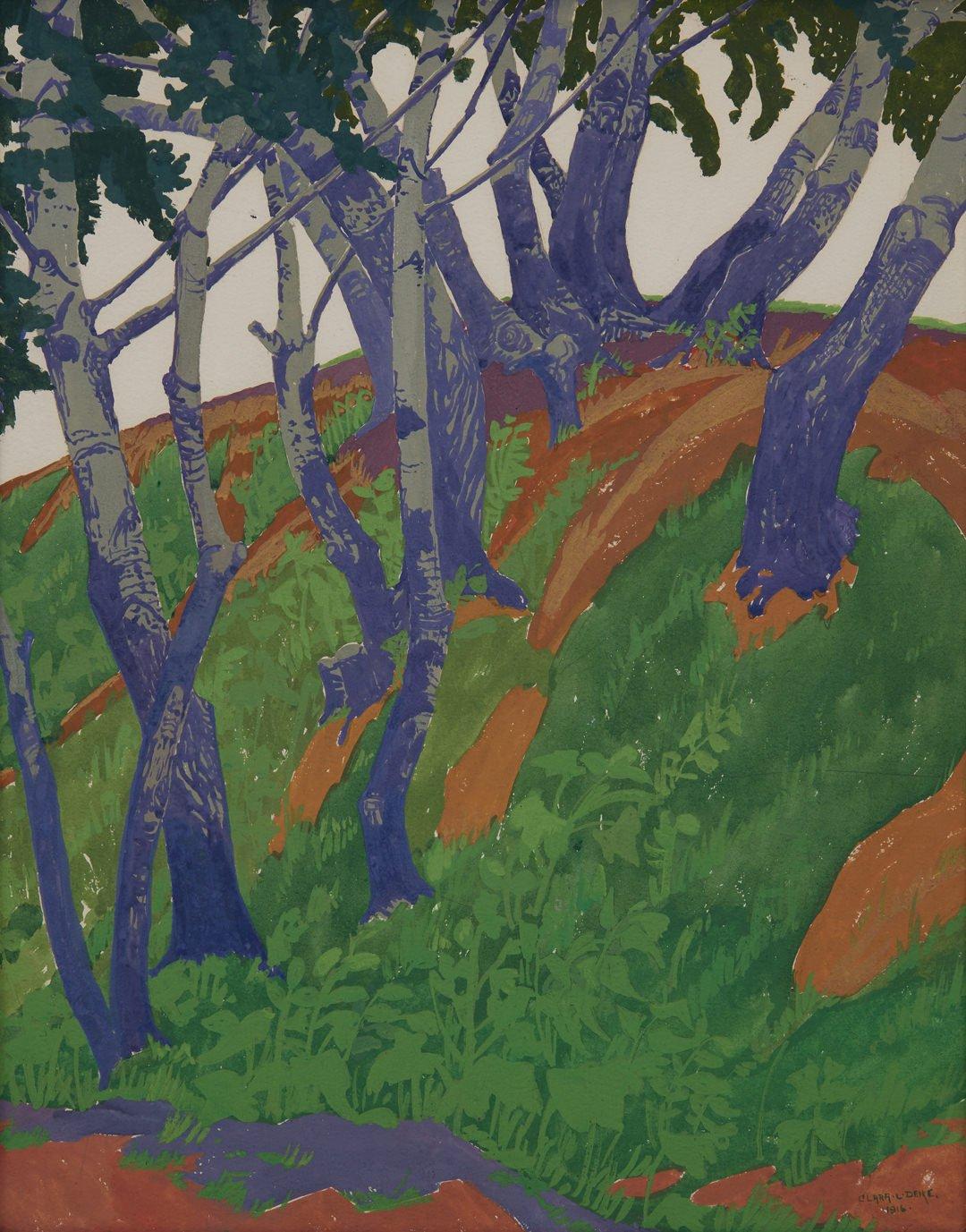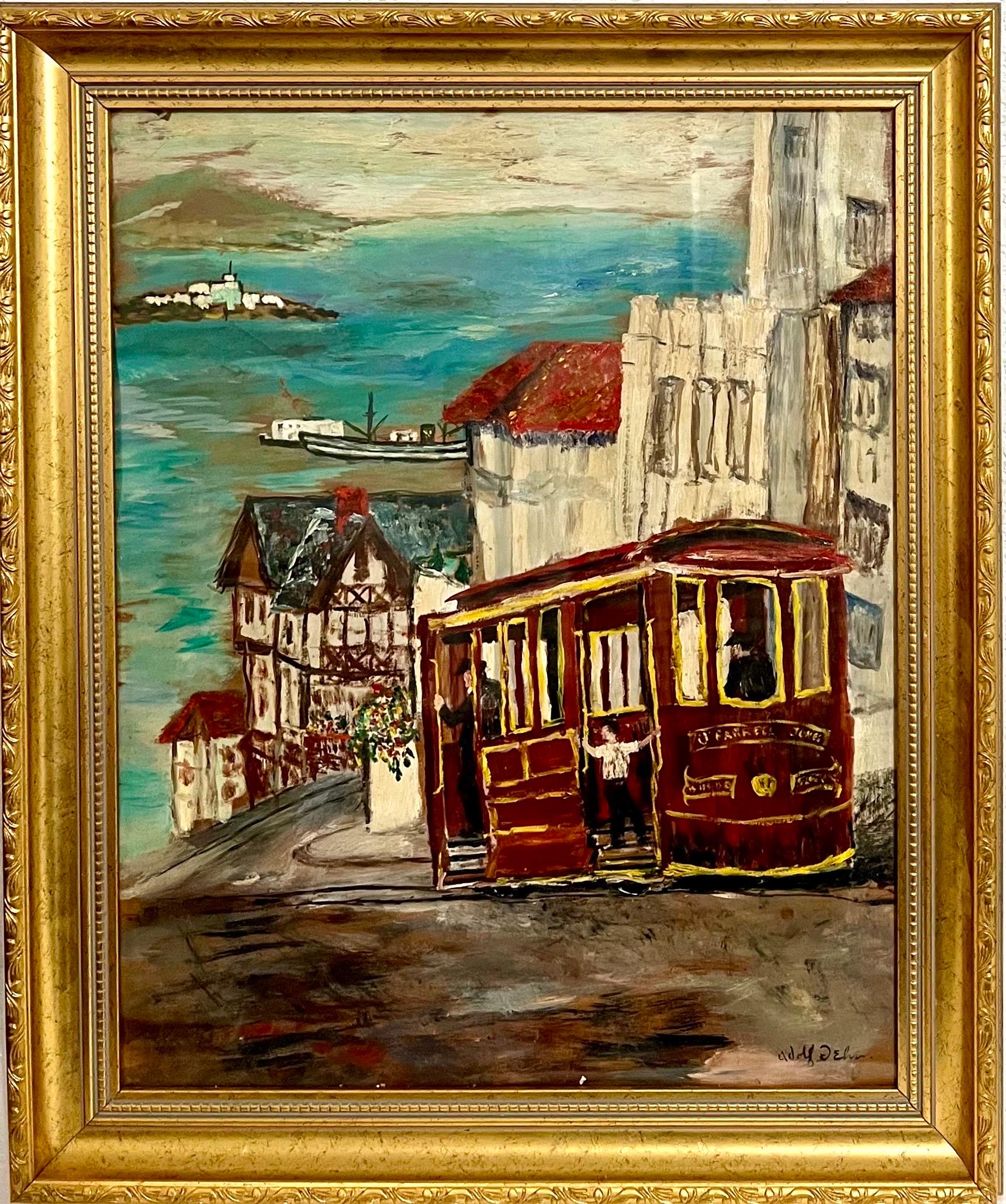Items Similar to Artists Sketching, California, 1940s Large Modernist Gouache Landscape Painting
Want more images or videos?
Request additional images or videos from the seller
1 of 13
Frederick ShaneArtists Sketching, California, 1940s Large Modernist Gouache Landscape Painting1949
1949
About the Item
"Artists Sketching (California)" is an American Modernist scene of three artists working with mountains in the background. Gouache on paper, signed, titled, and dated by the artist in the lower margin. Housed in a custom frame with all archival materials measuring 25.5 x 37.5 x 1.5 inches; image dimensions measure 20.25 x 29.75 inches.
Provenance: Estate of the Artist, Frederick Shane
About the artist:
Painter and printmaker, Missouri regionalist Frederick E. Shane specialized in genre scenes, landscapes, seascapes and portraits executed in a variety of media: oil, watercolor, mixed media, gouache, tempera and lithography. Fundamentally a realist, his work also contains some abstraction, expressionism and surrealism used in treating his subject matter.
In the summers of 1925-26 Shane studied with Randall Davey at the recently-founded Broadmoor Academy in Colorado Springs. The Academy was established in 1919 by Spencer and Julie Penrose, prominent philanthropists and art patrons, who donated their family residence for the creation of a local art institution. In the 1940s and early 1950s Shane maintained his contact with Colorado Springs Fine Arts Center (the successor institution to the Broadmoor Academy in 1936). He participated in a number of its annual Artists West of the Mississippi exhibitions and also became a close friend of Boardman Robinson, the Center’s director, and visiting artist Adolph Dehn whose graphic work and warm-hearted satire he admired.
His Colorado sketching trips with Dehn and Yasuo Kuniyoshi resulted in drawings whose imagery appeared in some of Shane’s prints and paintings, such as his lithograph, Farm in the Rockies (1945/46, aka Hayfield in the Rockies), and his oil on canvas, Owen’s Bookstore, Victor, Colorado (1942).
Some of his most notable paintings of the 1940s depict Colorado subjects in his consummate regionalist style. One of them in tempera, Chalk Cliffs, Mt. Princeton, Colorado, View from Old Hotel Antero (1944) presents a commanding panoramic view of a small cabin and grazing horses dominated by tall, craggy peaks.
After the death of his first wife in 1967, he married Dorothy March Henley, a widow, three years later. He had known her since they both were sixteen and she also had studied with Randall Davey at the Broadmoor Art Academy. He moved out to her home in Beverly Hills, California, where he installed a painting for himself and where he spent the balance of his life after retiring from the University of Missouri in 1971.
- Creator:Frederick Shane (1906 - 1992, American)
- Creation Year:1949
- Dimensions:Height: 25.5 in (64.77 cm)Width: 37.5 in (95.25 cm)Depth: 1.5 in (3.81 cm)
- Medium:
- Movement & Style:
- Period:
- Condition:Very good to excellent condition - please contact us for a detailed condition report.
- Gallery Location:Denver, CO
- Reference Number:
About the Seller
5.0
Platinum Seller
These expertly vetted sellers are 1stDibs' most experienced sellers and are rated highest by our customers.
Established in 1979
1stDibs seller since 2013
264 sales on 1stDibs
Typical response time: 5 hours
- ShippingRetrieving quote...Ships From: Denver, CO
- Return PolicyA return for this item may be initiated within 7 days of delivery.
More From This SellerView All
- Acoma Pueblo, New Mexico, 1970s Southwest Landscape Scene Gouache PaintingLocated in Denver, CO"Acoma Pueble (New Mexico) is a gouache on paper painting by Wolfgang Pogzoba (1936-1982) from 1978 of a landscape and an adobe home over a cliff side in the town of Acoma Pueblo, NM. Presented in a custom frame, outer dimensions measure 22 ⅜ x 25 inches. Image size is 12 x 15 inches. The Acoma Pueblo is located approximately 60 miles west of Albuquerque, New Mexico. Painting is clean and in good condition - please contact us for a detailed condition report. Expedited and international shipping is available - please contact us for a quote. About the Artist: Wolfgang Pogzeba...Category
1970s American Modern Landscape Paintings
MaterialsPaper, Gouache
- Golden Cycle Mill, Colorado, 1940s WPA Mining Watercolor Landscape, Black WhiteBy Charles Ragland BunnellLocated in Denver, COOriginal 1940s watercolor on paper painting by Charles Ragland Bunnell portraying a semi abstracted view of Golden Cycle Mill in Colorado Springs, Colorado. Painted in shades of black and gray. Presented in a custom black frame, outer dimensions measure 18 x 19 ½ x 1 ⅜ inches. Image sight size is 8 ⅛ x 9 ⅝ inches. Golden Cycle Mining and Reduction Company was a mining company in Colorado City (now Old Colorado City) in El Paso County, Colorado. Piece is clean and in excellent condition - please contact us for a detailed condition report. Expedited and international shipping is available - please contact us for a quote. About the artist: Artist and teacher, Charles (“Charlie”) Bunnell worked in a variety of styles throughout his career because as an artist he believed, “I’ve got to paint a thousand different ways. I don’t paint any one way.” At different times he did representational landscapes while concurrently involved with semi- or completely abstract imagery. He was one of a relatively small number of artists in Colorado successfully incorporating into their work the new trends emanating from New York and Europe after World War II. During his lifetime he generally did not attract a great deal of critical attention from museums, critics and academia. However, he personally experienced a highpoint in his career when Katherine Kuh, curator at the Art Institute of Chicago, personally chose one of his paintings – Why? - for its large exhibition of several hundred examples of abstract and surrealist art held in 1947-48, subsequently including it among the fifty pieces selected for a traveling show to ten other American museums. An only child, Bunnell developed his love of art at a young age through frequent drawing and political cartooning. In high school he was interested in baseball and golf and also was the tennis champion for Westport High School in Kansas City. Following graduation, his father moved the family to Denver, Colorado, in 1916 for a better-paying bookkeeping job, before relocating the following year to Colorado Springs to work for local businessman, Edmond C. van Diest, President of the Western Public Service Company and the Colorado Concrete Company. Bunnell would spend almost all of his adult life in Colorado Springs. In 1918 he enlisted in the United States Army, serving in the 62nd Infantry Regiment through the end of World War I. Returning home with a 10% disability, he joined the Zebulon Pike Post No. 1 of the Disabled American Veterans Association and in 1921 used the benefits from his disability to attend a class in commercial art design conducted under a government program in Colorado Springs. The following year he transferred to the Broadmoor Art Academy (founded in 1919) where he studied with William Potter and in 1923 with Birger Sandzén. Sandzén’s influence is reflected in Bunnell’s untitled Colorado landscape (1925) with a bright blue-rose palette. For several years thereafter Bunnell worked independently until returning to the Broadmoor Art Academy to study in 1927-28 with Ernest Lawson, who previously taught at the Kansas City Art Institute where Bunnell himself later taught in the summers of 1929-1930 and in 1940-41. Lawson, a landscapist and colorist, was known for his early twentieth-century connection with “The Eight” in New York, a group of forward-looking painters including Robert Henri and John Sloan whose subject matter combined a modernist style with urban-based realism. Bunnell, who won first-place awards in Lawson’s landscapes classes at the Academy, was promoted to his assistant instructor for the figure classes in the 1928-29 winter term. Lawson, who painted in what New York critic James Huneker termed a “crushed jewel” technique, enjoyed additional recognition as a member of the Committee on Foreign Exhibits that helped organize the landmark New York Armory Exhibition in 1913 in which Lawson showed and which introduced European avant-garde art to the American public. As noted in his 1964 interview for the Archives of American Art in Washington, DC, Bunnell learned the most about his teacher’s use of color by talking with him about it over Scotch as his assistant instructor. “Believe me,” Bunnell later said, “[Ernie] knew color, one of the few Americans that did.” His association with Lawson resulted in local scenes of Pikes Peak, Eleven Mile Canyon, the Gold Cycle Mine near Colorado City and other similar sites, employing built up pigments that allowed the surfaces of his canvases to shimmer with color and light. (Eleven Mile Canyon was shown in the annual juried show at the Carnegie Institute in Pittsburgh in 1928, an early recognition of his talent outside of Colorado.) At the same time, he animated his scenes of Colorado Springs locales by defining the image shapes with color and line as demonstrated in Contrasts (1929). Included in the Midwestern Artists’ Exhibition in Kansas City in 1929, it earned him the gold medal of the Kansas City Art Institute, auguring his career as a professional artist. In the 1930s Bunnell used the oil, watercolor and lithography media to create a mini-genre of Colorado’s old mining towns and mills, subject matter spurned by many local artists at the time in favor of grand mountain scenery. In contrast to his earlier images, these newer ones – both daytime and nocturnal -- such as Blue Bird Mine essentially are form studies. The conical, square and rectangular shapes of the buildings and other structures are placed in the stark, undulating terrain of the mountains and valleys devoid of any vegetation or human presence. In the mid-1930s he also used the same approach in his monochromatic lithographs titled Evolution, Late Evening, K.C. (Kansas City) and The Mill, continuing it into the next decade with his oil painting, Pikes Peak (1942). During the early 1930s he studied for a time with Boardman Robinson, director of the Broadmoor Art Academy and its successor institution, the Colorado Springs Fine Arts Center from 1930 to 1947. In 1934 Robinson gave him the mural commission under the Public Works of Art Project (PWAP) for West Junior High School in Colorado Springs, his first involvement in one of several New Deal art...Category
1940s American Modern Landscape Paintings
MaterialsPaper, Watercolor
- Church in Leadville, Colorado, 1930s Framed Landscape Watercolor Ink PaintingBy Jenne MagafanLocated in Denver, CORare WPA era original painting by Colorado/Woodstock modernist, Jenne Magafan (1916-1952). Church in Leadville, 1938 is presented in a custom frame with all archival materials, oute...Category
1930s American Modern Landscape Paintings
MaterialsArchival Ink, Watercolor, Archival Paper
- City Park, Denver, Colorado, Large Semi Abstract Colorful Oil LandscapeBy Edward MarecakLocated in Denver, COLarge format oil painting on canvas of City Park in Denver, Colorado by 20th century Denver modernist, Edward Marecak. Semi-abstract park scene with various types of trees, figures, ...Category
20th Century American Modern Landscape Paintings
MaterialsOil, Canvas
- Storm Over Victor (Colorado Mountain Town), 1940s WPA Era Landscape Oil PaintingLocated in Denver, COOil on board painting by George Vander Sluis (1915-1984) titled Storm Over Victor (Colorado Mountain Town) from 1946. WPA Era Mountain Landscape wi...Category
1940s American Modern Landscape Paintings
MaterialsOil, Board
- Near Watsonville, California, Mid Century Landscape Oil Painting House TreesBy Jon BlanchetteLocated in Denver, COMid 20th Century oil on artist board of a white house near Watsonville, California. 1950s landscape painting with house and trees. Presented in a...Category
Mid-20th Century American Modern Landscape Paintings
MaterialsOil, Board
You May Also Like
- 1950s "Figure in Shadow" Figurative Gouache Painting America ModernistBy Donald StacyLocated in Arp, TXDonald Stacy "Figure in Shadow" c.1950s Gouache paint on paper 24" x 18" unframed Unsigned Came from artist's estate Donald Stacy (1925-2011) New Jersey Studied: Newark School of Fine Art The Art Students League Pratt Graphic Arts Center University of Paris 1953-54 University of Aix-en-Provence 1954-55 Faculty: Art Department of the New School Museum of Modern Art School of Visual Arts Stacy Studio Workshop Exhibitions: Grand Central Moderns George Wittenborn The New School Print Exhibitions, Chicago University of Oklahoma Honolulu Museum Monclair Museum Wisconsin State College Louisiana Art...Category
Mid-20th Century American Modern Figurative Paintings
MaterialsPaper, Gouache
- "The Glorious Flight - Across the Channel with Louis Bleriot" - Children's BookBy Alice and Martin ProvensenLocated in Miami, FLStudy for "The Glorious Flight - Across the Channel with Louis Bleriot"; 1983; Gouache on Illustration Board; 14.5" x 13.75"; Signed Lower Right; Unframed. From Wikipedia, the free encyclopedia Alice Rose[1] Provensen (née Twitchell; August 14, 1918[2] – April 23, 2018[3]) and Martin Provensen...Category
1980s American Modern Figurative Paintings
MaterialsBoard, Gouache
- Happy California Prune Farmers - Female Illustrator - Mid CenturyLocated in Miami, FLCommercial illustration depicting happy California framers for California Prunes. The work is rendered in a charming and highly stylized manner. Unfr...Category
1950s American Modern Figurative Paintings
MaterialsGouache
- Hillside and Stream, early 20th century modernist Cleveland School paintingLocated in Beachwood, OHClara Deike (American, 1881-1964) Hillside and Stream, 1916 Gouache on paper Signed and dated lower right 22 x 18 inches 25.5 x 21.5 inches, framed A graduate of the Cleveland Schoo...Category
1910s American Modern Figurative Paintings
MaterialsGouache
- San Francisco Cable Car WPA Artist Adolf Dehn Modernist Art Gouache Oil PaintingBy Adolf DehnLocated in Surfside, FLADOLF ARTHUR DEHN (American, 1895-1969) San Francisco Bay Area street scene, with Trolley, Streetcar, Cable Car with bay and Alcatraz Island in background. Hand signed LRC. Sight 19" x 15", overall 23" x 19". Adolf Dehn (November 22, 1895 – May 19, 1968) was an American artist known mainly as a lithographer. Throughout his artistic career, he participated in and helped define some important movements in American art, including regionalism, social realism, and caricature. A two-time recipient of the Guggenheim Fellowship, he was known for both his technical skills and his high-spirited, droll depictions of human foibles. Adolph Dehn was born in 1895 in Waterville, Minnesota. He began creating artwork at the age of six, and by the time of his death had created nearly 650 images. Dehn went to the Minneapolis School of Art (known today as the Minneapolis College of Art and Design), where he met and became a close friend of Wanda Gag. In 1917 he and Gág were two of only a dozen students in the country to earn a scholarship to the Art Students League of New York. He was drafted to serve in World War I in 1918, but declared himself a conscientious objector and spent four months in a guardhouse detention camp in Spartanburg, SC and then worked for eight months as a painting teacher at an arm rehabilitation hospital in Asheville, NC. Later, Dehn returned to the Art Students League for another year of study and created his first lithograph, The Harvest. In 1921 Dehn's lithographs were featured in his first exhibition at Weyhe Gallery in New York City. From 1920 to 1921 in Manhattan, he was connected to New York's politically left-leaning activists. In 1921, he went to Europe. In Paris and Vienna he belonged to a group of expatriate intellectuals and artists, including Andrée Ruellan, Gertrude Stein, and ee cummings...Category
1930s American Modern Figurative Paintings
MaterialsOil, Gouache
- Simka Simkhovitch WPA Artist Oil Painting Gouache American Modernist PowerlineBy Simka SimkhovitchLocated in Surfside, FLSimka Simkhovitch (Russian/American 1893 - 1949) This came with a small grouping from the artist's family, some were hand signed some were not. These were studies for larger paintings. Simka Simkhovitch (Симха Файбусович Симхович) (aka Simka Faibusovich Simkhovich) (Novozybkov, Russia May 21, 1885 O.S./June 2, 1885 N.S.—Greenwich, Connecticut February 25, 1949) was a Ukrainian-Russian Jewish artist and immigrant to the United States. He painted theater scenery in his early career and then had several showings in galleries in New York City. Winning Works Progress Administration (WPA) commissions in the 1930s, he completed murals for the post offices in Jackson, Mississippi and Beaufort, North Carolina. His works are in the permanent collections of the Dallas Museum of Art, the National Museum of American Art and the Whitney Museum of American Art. Born outside Kyiv (Petrograd Ukraine) into a Jewish family who owned a small department store. During a severe case of measles when he was seven, Simcha Simchovitch sketched the views outside his window and decided to become an artist, over his father's objections. Beginning in 1905, he studied at the Grekov Odessa Art School and upon completion of his studies in 1911 received a recommendation to be admitted to the Imperial Academy of Arts. Though he enrolled to begin classes in architecture, painting, and sculpture at the Imperial Academy, he was dropped from the school roster in December because of the quota on the number of Jewish students and drafted into the army. Simchovitch served as a private in the 175th Infantry Regiment Baturyn [ru] until his demobilization in 1912. Re-enrolling in the Imperial Academy, he audited classes. Simka Simkhovitch exhibited paintings and sculptures in 1918 as part of an exhibition of Jewish artists and in 1919 placed 1st in the competition "The Great Russian Revolution" with a painting called "Russian Revolution" which was hung in the State Museum of Revolution. In 1922, Simkha Simkhovitch exhibited at the International Book Fair in Florence (Italian: Fiera Internazionale del Libro di Firenze). In 1924, Simkhovitch came to the United States to make illustrations for Soviet textbooks and decided to immigrate instead. Initially he supported himself by doing commercial art and a few portrait commissions. In 1927, he was hired to paint a screen for a scene in the play "The Command to Love" by Fritz Gottwald and Rudolph Lothar which was playing at the Longacre Theatre on Broadway. Art dealers began clamoring for the screen and Simkhovitch began a career as a screen painter for the theater. Catching the attention of the screenwriter, Ernest Pascal, he worked as an illustrator for Pascal, who then introduced him to gallery owner, Marie Sterner. Simkhovitch's works appeared at the Marie Sterner Gallery beginning with a 1927 exhibit and were repeated the following year. Simkhovitch had an exhibit in 1929 at Sterner's on circus paintings. In 1931, he held a showing of works at the Helen Hackett Gallery, in New York City and later that same year he was one of the featured artists of a special exhibit in San Francisco at the California Palace of the Legion of Honor in Lincoln Park. The exhibit was coordinated by Marie Sterner and included four watercolors, including one titled "Nudes". He is of the generation of Russian Soviet artists such as Isaac Pailes, Serge Charchoune, Marc Chagall, Chana Orloff, Isaac Ilyich Levitan, and Ossip Zadkine. In 1936, Simkhovitch was selected to complete the mural for the WPA Post office project in Jackson, Mississippi. The mural was hung in the post office and courthouse in 1938 depicted a plantation theme. Painted on the wall behind the judge’s bench, “Pursuits of Life in Mississippi”, a depiction of black workers engaged in manual labor amid scenes of white professionals and socialites, was eventually covered over in later years during renovations due to its stereotypical African American imagery. Simka painted what he thought was typical of Jackson. His impression of pre-civil rights Mississippi was evidently Greek Revival column houses, weeping willow trees, working class families, and the oppression of African Americans. He painted African American men picking cotton, while a white man took account of the harvest and a white judge advised a white family, calling it Pursuits of Life in Mississippi. Though clearly endorsed by the government and initially generally well-received, the mural soon raised concerns with locals as the climate toward racial segregation began to change. The main concern was whether depictions that show African Americans in subjugated societal roles should be featured in a courtroom. The following year, his painting "Holiday" won praise at an exhibition in Lincoln, Nebraska. In 1940, Simkhovitch's second WPA post office project was completed when four murals, "The Cape Lookout Lighthouse and the Orville W. Mail Boat", "The Wreck of the Crissie Wright", "Sand Ponies" and "Canada Geese" were installed in Beaufort, North Carolina. The works were commissioned in 1938 and did not generate the controversy that the Jackson mural had. The main mural is "The Wreck of the Crissie Wright" and depicts a shipwreck which had occurred in Beaufort in 1866. "The Cape Lookout Lighthouse and the Orville W. Mail Boat" depicted the lighthouse built in 1859 and the mail boat that was running mail during the time which Simkhovitch was there. The boat ran mail for the area until 1957. "Sand Ponies" shows the wild horses common to the North Carolina barrier islands and "Canada Geese" showed the importance of hunting and fishing in the area. All four murals were restored in the 1990s by Elisabeth Speight, daughter of two other WPA muralists, Francis Speight...Category
1930s American Modern Landscape Paintings
MaterialsGouache, Oil, Board
Recently Viewed
View AllMore Ways To Browse
Large Modernist
Painting Old California
1950s Paintings Large
Large Modern Graphic Art
California Mountain Landscapes
1950s Painting Landscape American
Large Mountain Landscape Painting
Frederick Brown
California Landscape Hill
Tall Modern Paintings
Large Seascape And Landscape
Old California Oil Painting
Frederick Fine Art
1940s Painting House
Oil Paintings California Spring
California Hills Landscape Painting
Large Modern Sketch
Modernist Gouache
